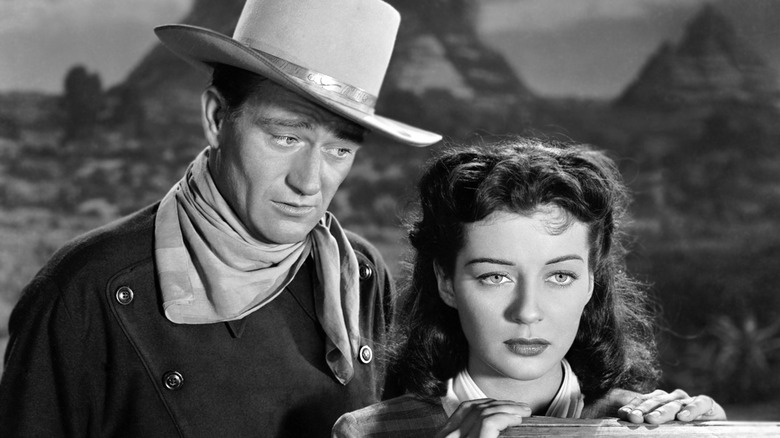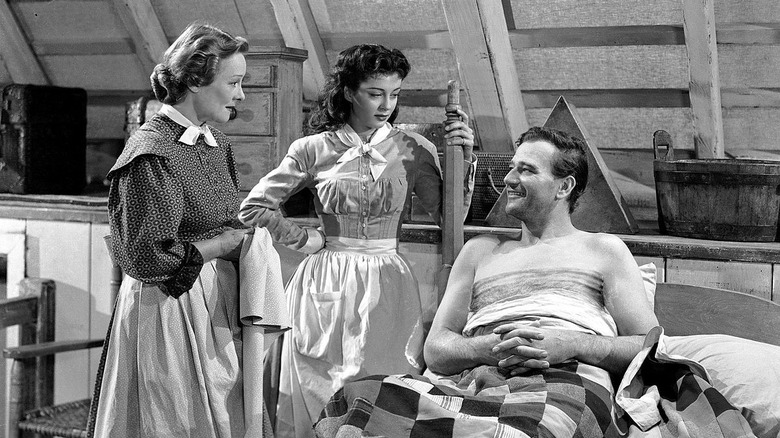
Though John Wayne's legacy will be forever entwined with that of his most frequent and beloved director, John Ford, the two really didn't start collaborating in earnest until well into Wayne's career. By 1947, Wayne had already appeared in over 100 films. True, eight of those were directed by Ford, but Wayne only starred in one of them: 1939's "Stagecoach," which turned him into a star.
The 1940s were a turbulent decade for Wayne. He began it on a high note, celebrating the critical and commercial love for "Stagecoach" at the Academy Awards. But as the '40s wore on, Wayne began to have serious doubts over what kind of star he wanted to be: did he want to write, produce, even direct, or just act? With World War II underway, Wayne starred in war picture after war picture -- would he ever return to the Western that proved so successful with audiences?
It was the matter of war, specifically Wayne's timid refusal to join the service, that drove the wedge between Ford and Wayne that prevented them from working together at all for the first half of the decade. According to the PBS series "The Pappy and the Duke," "Throughout the war, Ford urged the young actor 'to get in it,' and each time Wayne would beg off until he finished 'just one more picture.'" Driven by the desire to see his star rise after so many years of toiling, Wayne never joined the war effort. It was a decision that would "haunt him for the rest of his life."
Before his career turned around in 1948 with the back-to-back release of "Red River" and "Fort Apache," Wayne had to suffer even more. The Western "Angel And The Badman" was one of the biggest bombs of Wayne's career, but it taught him a valuable lesson about acting.
Action, Not Reaction

"Angel and the Badman" is a sweet, syrupy film about a renegade gunslinger (Wayne) who is nursed back to health after a firefight by a delicate Quaker woman (Gail Russell). The gunman, Quirt Evans, is eventually influenced by the gentle nature and compassionate humanity of the Quaker family, and he undergoes a "conversion" of sorts, unlearning all his rough and tumble ways. "Badman" no more.
The film is the sole directorial effort of James Edward Grant, who was introduced to Wayne shortly before production began. Though Grant would go on to write many films for Wayne, "Angel and the Badman" was such a flop commercially and with critics that it effectively barred him from ever taking the helm again. Some attributed the film's failure to launch to its initial runtime of almost two and a half hours (though it was quickly cut to a merciful 95). Some attributed it to Grant's inexpertise with dialogue. The New York Post remarked that "the dialogue in this picture frequently sounds as if it had been written by someone who couldn't think of what to say next."
Wayne heaped the blame upon himself. Before Howard Hawks could seize upon Wayne's chivalrous hero archetype and twist it into something malign, exposing all the rich layers underneath in "Red River," Wayne was at a loss how to properly convey feeling. He was even more at sea acting in a fundamentally romantic story opposite a leading lady as reactive as Gail Russell. So the Duke surmised, as Maurice Zolotow's "John Wayne: Shooting Star" put it, that "he would try to eschew introspection and the subtleties of facial suggestion, all those qualities of symbolism which he connoted by the term 'reaction.'"
As soon as Wayne dispensed with "the vagaries of subtle dialogue" and embraced enigmatic silence, his star began its truly majestic rise.
Read this next: The 20 Best Westerns Of All Time
The post Angel And The Badman's Box Office Failure Changed The Way John Wayne Approached Acting appeared first on /Film.
0 Comments